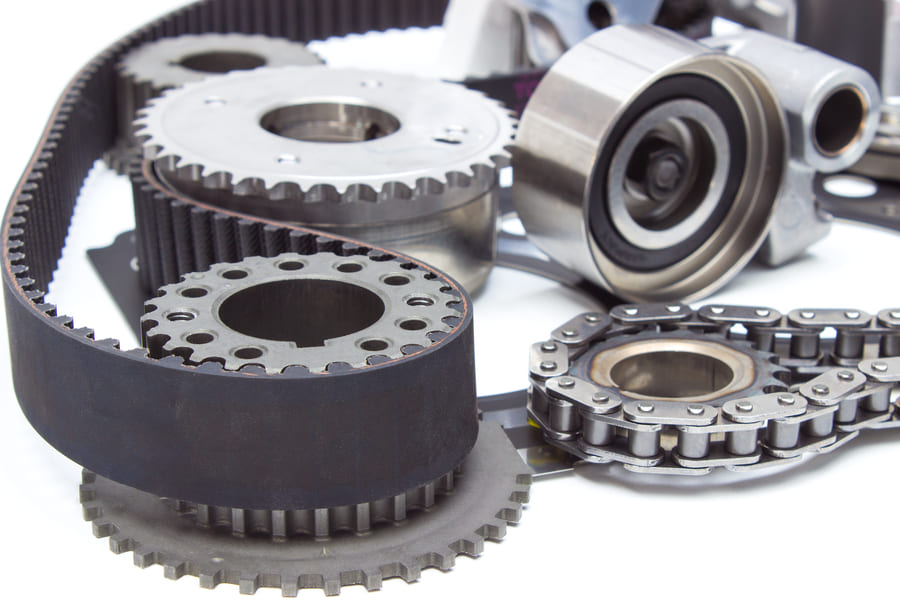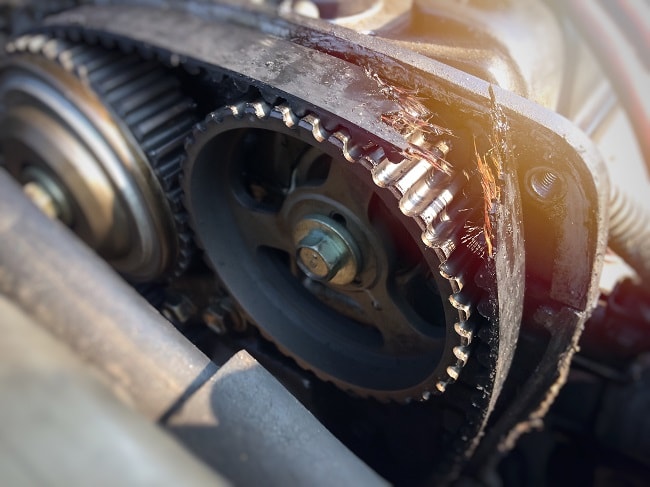
The timing belt of your car is an essential part of your engine management system. If this fails, it no longer runs properly. Because the engine timing is off when your timing belt snaps, it can cause serious or even irreparable engine damage. Therefore, it is important that you know when your engine’s timing belt needs to be replaced. In the following article we will give you some orientation points, but you can find the periods or engine running times that apply to your car in your vehicle technical manual.
Contents
What is a timing belt?
The primary function of your toothed belt is to transfer the crankshaft torque to your camshaft in 4-stroke engines. This in turn is responsible for ensuring that the engine exhaust and intake valves open and close in a coordinated manner. It is extremely important that the crankshaft and camshaft positions always match each other exactly. If your toothed belt is broken (i.e. it tears or slips), the alignment of these two shafts no longer matches. This often results in severe engine damage. You should therefore not delay changing your toothed belt, but stick to your specified toothed belt interval.

When should the toothed belt be replaced?
If your vehicle engine is actually equipped with a toothed belt, it must be replaced at fixed intervals. In contrast, it is usually not necessary to replace an existing engine timing chain within a normal engine life. Even if each manufacturer specifies very different toothed belt intervals for each individual engine, these often range between 100,000 and 200,000 kilometers driven. You will find detailed information on replacing this maintenance-requiring component in the technical operating instructions for your vehicle.
What happens if the change interval is exceeded?
The longer the prescribed toothed belt interval has been exceeded, the more likely it is that your toothed belt will tear or stretch too much. Both would lead to the synchronicity being lost and your vehicle engine coming out of its usual 4-stroke. To avoid engine damage, visit a specialist workshop as soon as possible where your toothed belt can be replaced by specialist staff. If you fail to do this, the risk of your toothed belt tearing increases with the engine performance. As already mentioned, this almost always results in severe engine damage, which not least often represents total engine or vehicle damage.

What are the signs that your timing belt is broken?
If your toothed belt tears while driving, you will usually notice this from a loud bang. Your vehicle engine then fails almost immediately. However, it can happen that your toothed belt is broken and yet does not tear immediately. Then your toothed belt often squeaks or other toothed belt noises occur. The cause is usually that it has stretched or teeth have been damaged. As a result, it slips over the associated pulleys, which causes the noise. Ultimately, however, this also means that the camshaft position (and thus the valve opening and closing processes) are no longer synchronous with the rotation of the engine crankshaft. So if you notice toothed belt noises, it is best not to drive any further, but have your car taken to the nearest specialist workshop.
What is the difference between toothed belt and timing chain?
The function of a toothed belt is identical to that of a so-called timing chain. Both types of power transmission from the crankshaft to the camshaft have specific advantages and disadvantages. In many cases, vehicle manufacturers rely on the toothed belt because it is a much cheaper component. A disadvantage, however, is that the maintenance costs increase significantly due to the timing belt change interval. A timing chain is more complex to produce and the assembly also requires much more extensive work. However, an invaluable advantage of using a timing chain is that it is almost always maintenance-free. This means that it does not have to be replaced regularly. Overall, almost 25% of newly registered vehicles with combustion engines are not equipped with a toothed belt.

What is the difference between toothed belts and V-belts?
The V-belt has a completely different function than the toothed belt. Although this also transmits torque from the engine’s crankshaft, its aim is to drive the water pump of your cooling circuit. The alternator is also driven by a V-belt. So if the V-belt breaks, the engine can continue to run (at least as long as the battery is still charged). In addition, the engine overheats over time because the cooling circuit is no longer working properly. All in all, tearing a V-belt is usually associated with fewer complications than tearing the toothed belt.
Frequently Asked Questions (FAQ)
⚠ How do I know whether my vehicle model has a toothed belt or a timing chain installed?
You can read about the type of power transmission from the crankshaft to the camshafts chosen by your vehicle manufacturer in the technical vehicle handbook. There you will also find information on exactly how often your timing belt should be replaced. If the installed timing chain needs to be serviced, you will also find this information there.
⚠ Can you change the timing belt yourself?
We strongly advise against this. You not only need a lot of experience for this, but also special tools and aids. In addition, you have to be very careful that the position of all driven components really corresponds exactly to the original condition in order not to risk engine damage. If there are errors when installing the tensioner and idler pulleys, this can result in increased toothed belt wear. This also means there is a risk that your toothed belt will tear.
Conclusion
The timing belt change interval is one of the most important maintenance intervals for your engine. Even if the air filter, oil filter and engine oil have to be replaced much more frequently, the toothed belt is an extremely important engine component. If your toothed belt is broken, your engine has often suffered serious damage. Therefore, only exceed the specifications of your vehicle manufacturer in an emergency and stick to the toothed belt interval.
A tip from CarTipsandmore: When changing the toothed belt, you should always make sure that the associated tensioners and deflection pulleys are also replaced. These have a comparable service life and ensure that your toothed belt is guided with little friction and at the same time always remains correctly tensioned.
